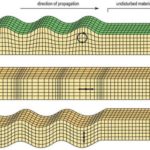EARTHQUAKES UNDER WATER
The moment magnitude scale (abbreviated as MMS; denoted as MW or M) is used by seismologists to measure the size of earthquakes in terms of the energy released.
nderstanding plate tectonics helps to explain the cause of submarine earthquakes. The Earth’s surface or lithosphere comprises tectonic plates which average approximately 50 miles in thickness, and are continuously moving very slowly upon a bed of magma in the asthenosphere and inner mantle. The plates converge upon one another, and one subducts below the other, or, where there is only shear stress, move horizontally past each other (see transform plate boundary below). Little movements called fault creep are minor and not measurable. The plates meet with each other, and if rough spots cause the movement to stop at the edges, the motion of the plates continue. When the rough spots can no longer hold, the sudden release of the built-up motion releases, and the sudden movement under the sea floor causes a submarine earthquake. This area of slippage both horizontally and vertically is called the epicenter, and has the highest magnitude, and causes the greatest damage. Wiki
Submarine earthquakes can also damage submarine communications cables, leading to widespread disruption of the Internet and international telephone network in those areas. This is particularly common in Asia, where many submarine links cross submarine earthquake zones such as the Pacific Ring of Fire.
In plate tectonics, a divergent boundary or divergent plate boundary (also known as a constructive boundary or an extensional boundary) is a linear feature that exists between two tectonic plates that are moving away from each other. Divergent boundaries within continents initially produce rifts which eventually become rift valleys. Most active divergent plate boundaries occur between oceanic plates and exist as mid-oceanic ridges. Divergent boundaries also form volcanic islands which occur when the plates move apart to produce gaps which molten lava rises to fill.
Current research indicates that complex convection within the Earth’s mantle allows material to rise to the base of the lithosphere beneath each divergent plate boundary.[1] This supplies the area with vast amounts of heat and a reduction in pressure that melts rock from the asthenosphere (or upper mantle) beneath the rift area forming large flood basalt or lava flows. Each eruption occurs in only a part of the plate boundary at any one time, but when it does occur, it fills in the opening gap as the two opposing plates move away from each other.
Over millions of years, tectonic plates may move many hundreds of kilometers away from both sides of a divergent plate boundary. Because of this, rocks closest to a boundary are younger than rocks further away on the same plate.





